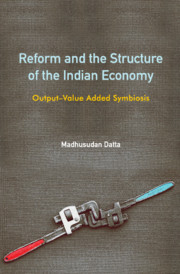Book contents
- Frontmatter
- Dedication
- Contents
- Tables
- Figures and Box
- Preface
- 1 Introduction: The Take-off
- 2 Growth and Structural Change since 1978–79: Issues in Measurement
- 3 Sectoral Shares in Indian GDP: How to Regard It?
- 4 Sectoral Growth: GVA–Output Dichotomy
- 5 Manufacturing Sector in the Indian Economy: Paradox of Growth and Stagnation
- 6 Growth and Sectoral GVA Adjustments
- 7 Demand for Intermediate Services
- 8 Linkages and Key Sectors in the Indian Economy
- 9 Conclusion: A Perspective of Indian Economic Growth
- References
- Index
8 - Linkages and Key Sectors in the Indian Economy
Published online by Cambridge University Press: 17 March 2020
- Frontmatter
- Dedication
- Contents
- Tables
- Figures and Box
- Preface
- 1 Introduction: The Take-off
- 2 Growth and Structural Change since 1978–79: Issues in Measurement
- 3 Sectoral Shares in Indian GDP: How to Regard It?
- 4 Sectoral Growth: GVA–Output Dichotomy
- 5 Manufacturing Sector in the Indian Economy: Paradox of Growth and Stagnation
- 6 Growth and Sectoral GVA Adjustments
- 7 Demand for Intermediate Services
- 8 Linkages and Key Sectors in the Indian Economy
- 9 Conclusion: A Perspective of Indian Economic Growth
- References
- Index
Summary
Do you anticipate sentiment, and poetry, and reverie? … Calm your expectations; … Something real, cool, and solid, lies before you; something unromantic as Monday morning, when all who work wake with a consciousness that they must rise and betake themselves thereto.
—Shirley: A Tale, Charlotte Bronte (1888: ch. 1)Introduction
The literature on the strategy of economic development initiated by Hirschman (1958) can be viewed as the primary inspiration for attempts to measure the pattern of industrial interlinkage. Hirschman advocated unbalanced growth to incentivize investment into areas served by strong demand or supply linkages, in the absence of serious structural rigidities like shortages, bottlenecks, low elasticities of demand and supply, and so on. The underlying assumptions were encouragement to private enterprise and responsiveness to market signals. Interindustry linkages have been studied with the objective of identifying pivotal industries in the sense of those having strong interrelations with other industries by way of being a key source of either demand for their products or supply of crucial intermediate inputs for production. Such industries, with maximum potential for being a spur to the system, are central for industrial development through their demand and supply interrelations. The present chapter is an exercise in the applicability of input–output based linkage measures in an analysis of interdependence in the Indian economic structure. Though the chapter follows linkage specifications within the Hirschman- Rasmussen tradition, it ventures into the supply-side model proposed by Ghosh (1958) for what is supposed to be a better measure of forward linkage.
In the next section, we discuss the intricacies of the relations between output on the one hand and final demand or value added on the other. The discussion helps explain interrelations that do not show up on the surface to final users, paving the way for classification of backward and forward linkages. The next section defines the concepts of linkages based on Leontief and Ghosh inverse matrices while the estimates of the linkage indices are presented in the appendix to the chapter. The subsequent section concludes the chapter by arranging the different sectors of the Indian economy according to the linkage intensities, by identifying the key sectors. The conclusion brings to sharp focus the justification of our division of services into two separate parts – Service-I and Service-II in the entire discourse.
- Type
- Chapter
- Information
- Reform and the Structure of the Indian EconomyOutput-Value Added Symbiosis, pp. 140 - 149Publisher: Cambridge University PressPrint publication year: 2020



